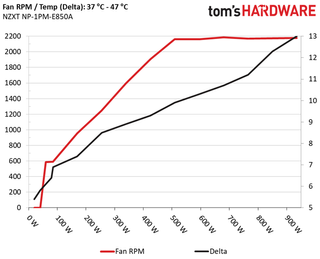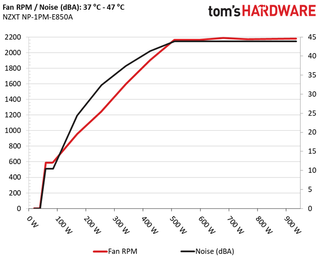NZXT E Series 850W PSU Review: An Analog Platform With Digital Enhancements
Why you can trust Tom's Hardware
Efficiency, Temperature & Noise
Efficiency
Our efficiency testing procedure is detailed here.
Using results from the previous page, we plotted a chart showing the E850’s efficiency at low loads, and loads from 10 to 110 percent of its maximum-rated capacity.




Efficiency under normal loads is a bit lower than Seasonic's original platform without the digital controllers. Of course, the difference is larger with light loads.
Efficiency At Low Loads
In the following tests, we measure the E850's efficiency at loads significantly lower than 10 percent of its maximum capacity (the lowest load the 80 PLUS standard measures). The loads we dial are 20, 40, 60, and 80W. This is important for representing when a PC is idle, with power-saving features turned on.
| Test # | 12V | 5V | 3.3V | 5VSB | DC/AC (Watts) | Efficiency | Fan Speed | PSU Noise | PF/AC Volts |
|---|---|---|---|---|---|---|---|---|---|
| 1 | 1.210A | 0.498A | 0.479A | 0.196A | 19.658 (26) | 67.505% | 0 RPM | <6.0 dB(A) | 0.870 |
| 12.019V | 5.034V | 3.350V | 5.120V | 29.121 | 115.34V | ||||
| 2 | 2.472A | 0.995A | 0.986A | 0.391A | 40.031 (41) | 79.241% | 0 RPM | <6.0 dB(A) | 0.938 |
| 12.024V | 5.032V | 3.347V | 5.115V | 50.518 | 115.33V | ||||
| 3 | 3.668A | 1.492A | 1.462A | 5.109A | 59.516 (54) | 83.401% | 587 RPM | 10.4 dB(A) | 0.963 |
| 12.027V | 5.032V | 3.347V | 5.109V | 71.361 | 115.30V | ||||
| 4 | 4.931A | 1.988A | 1.970A | 0.784A | 79.917 (69) | 85.869% | 588 RPM | 10.4 dB(A) | 0.975 |
| 12.030V | 5.032V | 3.346V | 5.103V | 93.068 | 115.27V |
The amount of energy required by the digital controllers doesn't allow for >70% efficiency with 20W load. It also affects the 40W load test, where the reading lands under 80%. We only see the 80% boundary crossed during the last two tests.
The bracketed DC wattage readings are the ones we observed in NZXT's software.
NZXT CAM Software Screenshots
We took a number of screenshots from the CAM software during our light load testing and compiled them into an album.












5VSB Efficiency
The ATX specification (revision 1.4), along with CEC, ErP Lot 3 2014 and ErP Lot 6 2010/2013, states that 5VSB standby supply efficiency should be as high as possible, recommending 75 percent or higher with 550mA, 1A, and 1.5A of load. The PSU should also achieve higher than 75% efficiency at 5VSB under full load, or with 3A if its max current output on this rail is higher than 3A.
We take six measurements: one each at 100, 250, 550, 1000, and 1500mA, and one with the full load the 5VSB rail can handle.
| Test # | 5VSB | DC/AC (Watts) | Efficiency | PF/AC Volts |
|---|---|---|---|---|
| 1 | 0.100A | 0.513 | 73.496% | 0.064 |
| 5.124V | 0.698 | 115.37V | ||
| 2 | 0.250A | 1.280 | 76.190% | 0.147 |
| 5.120V | 1.680 | 115.38V | ||
| 3 | 0.550A | 2.813 | 77.259% | 0.264 |
| 5.113V | 3.641 | 115.37V | ||
| 4 | 1.000A | 5.104 | 76.949% | 0.359 |
| 5.103V | 6.633 | 115.37V | ||
| 5 | 1.500A | 7.641 | 77.252% | 0.411 |
| 5.093V | 9.891 | 115.37V | ||
| 6 | 3.000A | 15.168 | 75.651% | 0.474 |
| 5.056V | 20.050 | 115.36V |


The 5VSB rail is not particularly efficient. In its next version of the Focus platform, Seasonic should make improvements in order to keep up with competing PSUs and newer efficiency regulations (CEC and ErP Lot 6/3) that ask for higher efficiency from this rail.
Power Consumption In Idle And Standby
In the table below, you'll find the power consumption and voltage values of all rails (except -12V) when the PSU is idle (powered on, but without any load on its rails), and the power consumption when the PSU is in standby mode (without any load, at 5VSB).
| Mode | 12V | 5V | 3.3V | 5VSB | Watts | PF/AC Volts |
|---|---|---|---|---|---|---|
| Idle | 12.014V | 5.035V | 3.350V | 5.126V | 8.827 | 0.524 |
| 115.4V | ||||||
| Standby | 0.049 | 0.005 | ||||
| 115.4V |


Vampire power is minimal with both 115V and 230V input.
Fan RPM, Delta Temperature, And Output Noise
Our mixed noise testing is described in detail here.
The first chart below illustrates the cooling fan's speed (in RPM), and the delta between input and output temperature. The results were obtained at 37°C (98.6°F) to 47°C (116.6°F) ambient temperature.

The next chart shows the cooling fan's speed (again, in RPM) and output noise. We measure acoustics from one meter away, inside a hemi-anechoic chamber. Background noise inside the chamber is below 6 dB(A) during testing (it's actually much lower, but our sound meter’s microphone hits its floor), and the results are obtained with the PSU operating at 37°C (98.6°F) to 47°C (116.6°F) ambient temperature.

The following graph illustrates the fan's output noise over the PSU's operating range. The same conditions of the above graph apply to our measurements, though the ambient temperature is between 30°C (86°F) to 32°C (89.6°F).

Even using the Silent profile, NZXT's passive mode doesn't last long. The E850 starts getting noisy at around 425W. With more than 540W, we measure >40 dB(A).
MORE: Best Power Supplies
MORE: How We Test Power Supplies
MORE: All Power Supply Content
Current page: Efficiency, Temperature & Noise
Prev Page Load Regulation, Hold-Up Time & Inrush Current Next Page Protection Features & DC Power SequencingStay on the Cutting Edge
Join the experts who read Tom's Hardware for the inside track on enthusiast PC tech news — and have for over 25 years. We'll send breaking news and in-depth reviews of CPUs, GPUs, AI, maker hardware and more straight to your inbox.
Aris Mpitziopoulos is a Contributing Editor at Tom's Hardware US, covering PSUs.